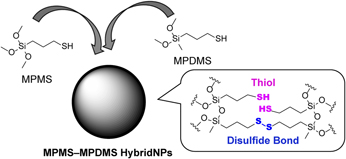Crossref Citations
This article has been cited by the following publications. This list is generated based on data provided by
Crossref.
Poscher, Vanessa
and
Salinas, Yolanda
2020.
Trends in Degradable Mesoporous Organosilica-Based Nanomaterials for Controlling Drug Delivery: A Mini Review.
Materials,
Vol. 13,
Issue. 17,
p.
3668.
M. Ways, Twana Mohammed
Ng, Keng Wooi
Lau, Wing Man
and
Khutoryanskiy, Vitaliy V.
2020.
Silica Nanoparticles in Transmucosal Drug Delivery.
Pharmaceutics,
Vol. 12,
Issue. 8,
p.
751.
Zhang, Lu
Wu, Hao
Li, Yuanpei
and
Lam, Kit S.
2020.
Nanoengineered Biomaterials for Advanced Drug Delivery.
p.
243.
Nakamura, Michihiro
Hayashi, Koichiro
Nakamura, Junna
Mochizuki, Chihiro
Murakami, Takuya
Miki, Hirokazu
Ozaki, Shuji
and
Abe, Masahiro
2020.
Near-Infrared Fluorescent Thiol-Organosilica Nanoparticles That Are Functionalized with IR-820 and Their Applications for Long-Term Imaging of in Situ Labeled Cells and Depth-Dependent Tumor in Vivo Imaging.
Chemistry of Materials,
Vol. 32,
Issue. 17,
p.
7201.
Chinnathambi, Shanmugavel
and
Tamanoi, Fuyuhiko
2020.
Recent Development to Explore the Use of Biodegradable Periodic Mesoporous Organosilica (BPMO) Nanomaterials for Cancer Therapy.
Pharmaceutics,
Vol. 12,
Issue. 9,
p.
890.
Beaupre, Danielle M.
and
Weiss, Richard G.
2021.
Thiol- and Disulfide-Based Stimulus-Responsive Soft Materials and Self-Assembling Systems.
Molecules,
Vol. 26,
Issue. 11,
p.
3332.
Mochizuki, Chihiro
Nakamura, Junna
and
Nakamura, Michihiro
2021.
Development of Non-Porous Silica Nanoparticles towards Cancer Photo-Theranostics.
Biomedicines,
Vol. 9,
Issue. 1,
p.
73.
Al Mahrooqi, Jamila H.
Khutoryanskiy, Vitaliy V.
and
Williams, Adrian C.
2021.
Thiolated and PEGylated silica nanoparticle delivery to hair follicles.
International Journal of Pharmaceutics,
Vol. 593,
Issue. ,
p.
120130.
Purikova, Olha
Tkachenko, Ihor
Šmíd, Břetislav
Veltruská, Kateřina
Dinhová, Thu Ngan
Vorokhta, Maryna
Kopecký, Vladimír
Hanyková, Lenka
and
Ju, Xiaohui
2022.
Free‐Blockage Mesoporous Silica Nanoparticles Loaded with Cerium Oxide as ROS‐Responsive and ROS‐Scavenging Nanomedicine.
Advanced Functional Materials,
Vol. 32,
Issue. 46,
Nakamura, Michihiro
Nakamura, Junna
Mochizuki, Chihiro
Kuroda, Chika
Kato, Shigeki
Haruta, Tomohiro
Kakefuda, Mayu
Sato, Shun
Tamanoi, Fuyuhiko
and
Sugino, Norihiro
2022.
Analysis of cell–nanoparticle interactions and imaging of in vitro labeled cells showing barcorded endosomes using fluorescent thiol-organosilica nanoparticles surface-functionalized with polyethyleneimine.
Nanoscale Advances,
Vol. 4,
Issue. 12,
p.
2682.
Ba, Jingwen
Han, Yandong
Zhang, Lin
and
Yang, Wensheng
2023.
Au (III) cross-linked hollow organosilica capsules from 3-aminopropyltriethoxysilane.
Journal of Colloid and Interface Science,
Vol. 641,
Issue. ,
p.
428.
Zhang, Cheng
Zhang, Liyuan
Ma, Yuanyuan
Ju, Shenghong
and
Fan, Wenpei
2023.
Design of Ultrasmall Silica Nanoparticles for Versatile Biomedical Application in Oncology: A Review.
Nano Biomedicine and Engineering,
Vol. 15,
Issue. 4,
p.
436.
Zhai, Qianqian
Zhao, Wenxue
Lu, Zhihua
Wang, Jing
Zhao, Di
and
Zhou, Guangli
2023.
Trimethoxysilane Coupling Agents: Hydrolysis Kinetics by FTNIR PLS Model, Synthesis and Characterization of Fluorinated Silicone Resin.
Silicon,
Vol. 15,
Issue. 9,
p.
3945.
Salve, Rajesh
Kumar, Pramod
Chaudhari, Bhushan P.
and
Gajbhiye, Virendra
2023.
Aptamer Tethered Bio-Responsive Mesoporous Silica Nanoparticles for Efficient Targeted Delivery of Paclitaxel to Treat Ovarian Cancer Cells.
Journal of Pharmaceutical Sciences,
Vol. 112,
Issue. 5,
p.
1450.
Beaupre, Danielle M.
Goroncy, Alexander K.
and
Weiss, Richard G.
2023.
Influence of Concentration of Thiol-Substituted Poly(dimethylsiloxane)s on the Properties, Phases, and Swelling Behaviors of Their Crosslinked Disulfides.
Macromol,
Vol. 3,
Issue. 1,
p.
36.





